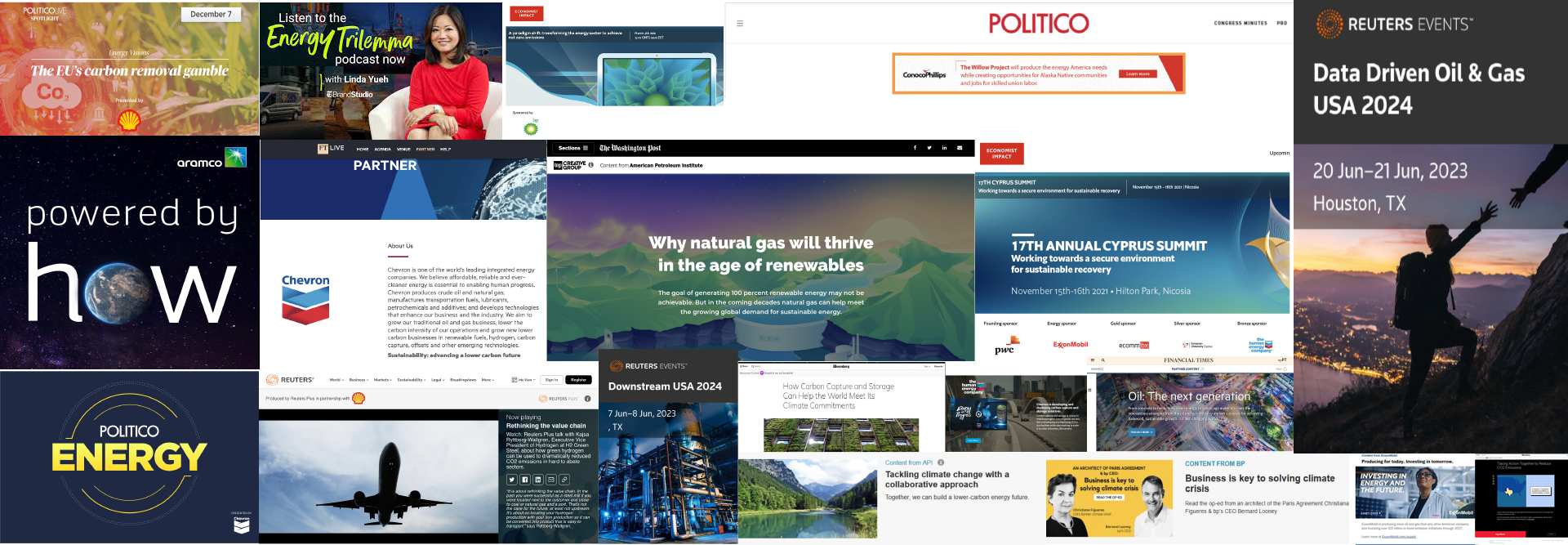
How the Media Greenwashes the Fossil Fuel Industry
Many of the world’s most reputable publications use their credibility to sell advertorials that protect polluters and confuse readers.
The CEO of Exxon, Darren Woods, celebrates the potential of carbon capture to dramatically reduce global emissions. Saudi Aramco says in its podcast that the fossil fuel industry is innovating new climate solutions. BP’s podcast proclaims more of the same. These sound like examples pulled from the public-relations departments of the fossil fuel industry, but they were respectively produced and promoted by Bloomberg, Reuters, and The New York Times. Over decades, these media companies built trust with readers; now they are wrapping their hard-won credibility around fossil fuel companies, confusing readers and protecting corporate interests.
These news outlets are not alone. We analyzed hundreds of advertorials and events as well as ad data from Media Radar and found that many of the world’s most trusted English-language news publications help fossil fuel companies mislead readers about topics like the promise of carbon capture, the potential of “renewable biogas,” and how much the industry contributes to the energy transition. All the companies we reviewed—Bloomberg, The Economist, the Financial Times, The New York Times, Politico, Reuters, and The Washington Post—create advertising content for major fossil fuel corporations. Some of these outlets allow these companies to sponsor their events. Reuters goes even further, organizing custom events for the industry explicitly designed to remove the “pain points” holding back faster production of oil and gas.
Our analysis focused on the three years from October 2020 to October 2023, because during this time, calls for the media, public relations, and advertising companies to cut their commercial ties with fossil fuel clients increased as more people became aware of the role of industry messaging in slowing climate action.
Now with the UN climate talks in the United Arab Emirates, oil and gas companies are sponsoring even more advertorials, newsletters, and events with media partners than usual, and they are primarily designed to portray the industry as the gatekeeper to climate solutions.
The media plays a fundamental role in shaping policymakers’ and the public’s understanding of climate issues, according to Max Boykoff, who contributed research and analysis to the most recent climate-mitigation report from the UN-backed Intergovernmental Panel on Climate Change (IPCC). “People aren’t picking up the IPCC report or peer-reviewed research to understand climate change,” said Boykoff, a professor of environmental studies at the University of Colorado, Boulder, where he directs the Media and Climate Change Observatory. “People are reading about it in the news, that’s what shapes their understanding.”
Spokespeople for Bloomberg, the Financial Times, The New York Times, The Washington Post, and Reuters told us that advertorial content is created by staff that are separated from the newsroom and their journalists are independent from their ad sales efforts. (The Economist and Politico did not respond to requests for comment). But the independence of these outlets’ journalists is not the point; what’s important is whether readers understand the difference between reporting and advertising. And according to a growing body of peer-reviewed research, they do not. A 2016 Georgetown University study, for example, found that about two-thirds of people confused advertorials—also known as native advertising—for “real” content. A 2018 Boston University study found that only one in 10 people recognized native advertising as advertising, rather than reporting. A 2016 study conducted by Stanford University researchers found that 80 percent of students mistook native ads for reported stories. That’s particularly important in the context of climate, where the sponsored content often contradicts the news articles.
Michelle Amazeen, the lead author on the Boston University study, found that those who did recognize sponsored content for what it was thought less of the outlet they were reading. “It tarnishes the reputation of that news outlet,” Amazeen said. “So it’s baffling to me why newsrooms are continuing to pursue this.”
“In theory, these complaints could possibly be addressed with better labeling and smarter design,” Jay Rosen, journalism professor at New York University, said. “But if you’re saying that even when they are properly labeled and carefully set off from the real journalism, these advertorials weaken trust and miscommunicate about climate change, that is a problem that cannot be solved within the industry consensus around sponsored content. It’s implicitly calling for a new consensus.”
Align your “climate narrative”
This year’s annual UN climate negotiations, known as the Conference of the Parties or COP, is in Dubai, the largest city in one of the world’s top oil-producing countries, the United Arab Emirates. It will be presided over by Sultan Ahmed Al Jaber, the head of Abu Dhabi’s state oil company, ADNOC, and it is expected to be the most industry-influenced COP yet. Fossil fuel companies, including ADNOC, are seeking to preserve their business models by promoting carbon capture and storage, hydrogen, and carbon offsets as viable climate solutions. As COP28 president, Al Jaber has backed these technologies in the lead-up to the summit. Climate reporters at all of the outlets we analyzed have diligently covered the challenges these technologies face, but when that reporting is placed alongside corporate-sponsored content touting the benefits of these technologies, it leaves readers baffled.
A Reuters Plus podcast for Aramco produced this year focused heavily on these technologies, for example, and was preceded by The Energy Trilemma, a podcast The New York Times created for BP in fall 2022 about how high-emitting industries are decarbonizing, mostly through technology and not by reducing the development or use of fossil fuels. Bloomberg Media Studios, meanwhile, created a video for ExxonMobil last year touting both carbon capture and hydrogen, particularly a project that aims to capture 100 million metric tons of CO2 annually by 2040. In the video, Exxon CEO Darren Woods says the company is “ready to deploy CCS to reduce the world’s emissions,” but leaves out the fact that the company also plans to increase annual carbon-dioxide emissions by as much as the output of the entire nation of Greece—news Bloomberg’s climate reporters broke.
Reuters Events also offers to help corporations hone their “climate narrative” at COP28, via opportunities to secure “exclusive interviews,” places at high-level roundtables, coverage on the Reuters website, exclusive dinner invites, and a Reuters presence in corporate pavilions at the Dubai expo center hosting the negotiations.
The enormous influence oil and gas executives are wielding at COP28 have thrown commercial partnerships between such outlets and the fossil fuel industry into sharper focus. As IPCC’s Boykoff said, “The considerations around what is the role of carbon-based industry in partnering with media organizations is not too dissimilar to the debates and discussions around what kind of role the carbon-based industry interests have in the climate talks themselves.”
“Gross,” “undermining,” and “dangerous”
Popular
“swipe left below to view more authors”Swipe →Reuters and other outlets striking commercial deals with fossil fuel companies are trusted not only by the public, but also by politicians and other key decision-makers. According to communications agency BCW’s annual survey of media brands in Europe, Politico, Reuters, the Financial Times, and The Economist are the most influential media for EU decision-makers. They are also amongst the fossil fuel industry’s favorite publishers.
These outlets’ advertorials and events that greenwash the industry’s preferred climate solutions haven’t just been happening at COP28. Over the past three years, the Financial Times has created dedicated web pages for fossil majors, including Equinor and Aramco, along with native content and videos, all of it focused on promoting oil and gas as a key component of the energy transition, while its “FT Live” event focused on the energy transition features speakers from BP, Chevron, Eni, and Essar. The Economist created a content hub around electrified transport for BP, which was also a platinum sponsor of its 2020 Sustainability Week event, while Petronas and Chevron sponsored the magazine’s “Future of Energy Week” event in 2022. Politico publishes a high volume of sponsored content for the fossil fuel industry: It has run native ads more than 50 times for the American Petroleum Institute in the last three years; sent at least 20 newsletters sponsored by BP and another 19 newsletters sponsored by Chevron, which also sponsors its annual “Women Rule” summit; organized 37 e-mail campaigns for ExxonMobil; and had Shell sponsor every one of its Energy Vision summits since 2017.
According to data from ad data service Media Radar, The New York Times took in more than $20 million in revenue from fossil fuel advertisers from October 2020 to October 2023, twice what any other outlet earned from the industry. That number is due largely to the paper’s relationship with Saudi Aramco, which brought in $13 million in ad revenue during that three-year period, via a combination of print, mobile, and video ads as well as sponsored newsletters. That revenue does not include creative services fees paid to the Times’ internal brand studio. New York Times spokesperson Alexis Mortenson said that the T Brand Studio does create custom content in print, video, and digital (including podcasts) for fossil fuel advertisers, and “we allow dark social posts if we’re creating this content.”
“Dark social posts” are social posts promoted as ads to a specific audience; they cannot be found organically and do not appear on a brand’s timeline. Mortenson noted, “We no longer allow organic social posts. Additionally, we allow fossil fuel advertisers to sponsor some newsletters. Fossil fuel advertisers, however, cannot sponsor any climate-related newsletter, such as Climate Forward and [climate journalist] David Wallace-Wells’s newsletter.”
Climate reporters at these outlets, who requested anonymity to avoid professional repercussions, described the practice as “gross,” “undermining,” and “dangerous.”
“Not only does it undermine the climate journalism these outlets are producing, but it actually signals to readers that climate change is not a serious issue,” one climate reporter said.
Another journalist at a major media organization said the outlet had undermined its credibility by striking commercial deals with oil and gas companies with a long history of hiring public relations agencies to cast doubt on climate science. “Where is our integrity? How can we expect people to take our climate coverage seriously after everything these oil companies have done to hide the truth?”
Harvard climate disinformation expert Naomi Oreskes agreed: “It’s really outrageous that outlets like The New York Times or Bloomberg or Reuters would lend their imprimatur to content that is misleading at best and in some cases outright false.”
“Vast sums of money”
The fossil fuel industry’s attempts to extend its social license by buying friendly advertorials and other sponsored content date back to 1970, when Mobil Oil Vice President of Public Affairs Herb Schmertz worked with The New York Times to create the advertorial. The company proceeded to run these pieces, which Schmertz described as “political pamphlets,” in the Times every week for decades, extending the program to include dozens of other outlets. The rest of the industry followed suit, and the practice has continued ever since. A peer-reviewed 2017 study of Mobil and then ExxonMobil’s New York Times advertorials found that 81 percent of the ones that mentioned climate change emphasized doubt in the science.
The advent of “brand studios” inside most major media outlets over the past decade has supercharged such content programs. Now many publications have staff dedicated to creating content for advertisers, and the outlets market their ability to tailor content to their readership. These offerings come at a higher cost than traditional ad buys, making them increasingly important to for-profit newsrooms facing a crisis in the traditional revenue models. And fossil fuel companies have been happy to pay.
“They wouldn’t be spending vast sums of money on these campaigns if they didn’t have a payoff, and it’s well-documented that for decades the fossil fuel industry has leveraged and weaponized and innovated the media technology of the day to its advantage,” University of Miami researcher Geoffrey Supran, a coauthor of the 2017 advertorial study with Oreskes, said. “It’s sometimes treated as an historical phenomenon, but in reality, we’re living today with the digital descendants of the editorial campaigns pioneered by the fossil fuel industry—the old strategy is very much alive and well.”
Taking a page from Schmertz’s book, The Washington Post Creative Group—the paper’s internal brand studio—describes on its website how it goes about “influencing the influencers.”
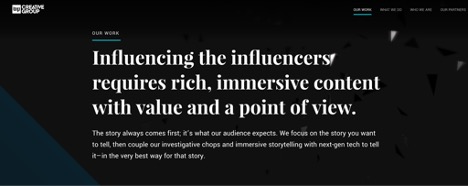
In 2022 alone, ExxonMobil sponsored more than 100 editions of Washington Post newsletters. Throughout 2020 and 2021, it also ran a series of editorials for the American Petroleum Institute on its website. API is the most powerful fossil fuel lobby in the US, and the Post ran a multimedia piece arguing that fossil gas was a complement to renewable energy and repeating talking points about the intermittency of renewable energy that the paper’s news reporters often debunk. During this time, the Post editorial team published Pulitzer Prize–winning climate reporting and expanded its climate coverage.
Reuters tops the list
Of all the outlets we reviewed, only Reuters offers fossil fuel advertisers every possible avenue to reach its audience. Its event arm even produces custom events for the industry, a notable shift for an outlet that has always counted “freedom from bias” as a core value—a pillar of the Trust Principles Reuters adopted to protect its independence during World War II.
Since Reuters News, a subsidiary of Canadian media conglomerate Thomson Reuters, acquired an events business in 2019, the distinction between the company’s newsroom and its commercial ventures has increasingly blurred, with Reuters journalists routinely taking part as moderators and interviewers for Reuters Events and proposing guest speakers.
For its Hydrogen 2023 event, Reuters Events produced a companion whitepaper on the top 100 hydrogen innovators, which it then used to market the event in various other outlets; it looks like it could be a product of the newsroom, and topping the list of innovators are key event sponsors, Chevron and Shell.
Reuters Events also stages fossil fuel industry trade shows explicitly aimed at maximizing production of oil and gas; it also creates digital events and webinars for vendors in the fossil fuel supply chain looking to connect with oil and gas companies. In a media kit for “content opportunities in the upstream industry,” Reuters Events staff offers to produce webinars, whitepapers, and live-event interviews for those hoping to get in front of its “unrivalled audience reach of decision makers in the oil & gas industry.”
In June 2023, Reuters Events convened hundreds of oil, gas, and tech executives in Houston for “Reuters Events Data-driven Oil & Gas USA 2023,” a conference held under the banner “Scaling Digital to Maximize Profit.”
“Time is money, which is why our agenda gets straight to key pain points holding back drilling and production maximization,” the conference website said.
In December 2022, Reuters ran an event sponsored by lobby group the Oil and Gas Climate Initiative, which includes many of the world’s largest oil companies, to discuss the “major part” fossil fuel companies “play in ensuring a sustainable energy transition,” and tweeted industry talking points from the Reuters Events twitter account.
Meanwhile Reuters’s in-house creative studio produces native print, audio, and video content, whitepapers; and newsletters for multiple oil majors, including Shell, Saudi Aramco, and BP. Reuters has also partnered with Chevron, the “diamond” sponsor of both its flagship Reuters Impact climate event in London in September 2023 and its Global Energy Transition Summit in New York this coming June 2024.
“Business-to-business publishers always had an events revenue stream, but consumer-facing news publications didn’t really get into the events business until digital advertising became commodified,” media analyst Ken Doctor said. Now events represent 20 to 30 percent of revenue for some publications. Doctor said they’re appealing for advertisers, too. “It’s a thought-leader exercise,” he said. “There are only a few top media brands out there, and if you are associated with any of them, there is a lot of tangential brand building benefit to that.”
The additional revenue may come at a reputational cost for news outlets, though. According to Oreskes, events run by media organizations that explicitly endorse the fossil fuel industry’s agenda pose even greater conflicts of interests than the advertorials running alongside climate coverage. “It really crosses the line because now they’re actually manufacturing content,” she said. “They’re manufacturing content that at best is completely one-sided and at worst is disinformation, and pushing that to their readers.”
After seeing the scope of Reuters’s involvement with the fossil fuel industry, we wondered how an outlet that’s producing events for fossil fuel companies, aimed at increasing oil and gas development, could qualify for membership in Covering Climate Now, an organization that offers newsrooms the opportunity to “demonstrate leadership among their peers—and to show readers, listeners and viewers that they’re committed to telling the climate story with the rigor, focus, and urgency it deserves.” Covering Climate Now declined to share this article with their network of publications.
“Covering Climate Now has had no communication with Reuters about any activities backing faster development of fossil fuels,” Mark Hertsgaard, the executive director of Covering Climate Now, said in a written statement. “Covering Climate Now has always taken a big-tent approach to our partnership with news organizations. This story raises serious questions about news media responsibility in climate reporting, and Covering Climate Now plans to think more deeply about these questions and how we might adjust our policies going forward.”
“PR campaigns”
As their content marketing about the journey to net zero continues to get bigger and better, oil majors’ investments in fossil fuel development have only increased. A peer-reviewed study comparing oil majors’ advertising claims and actions, published in the journal Plos One in 2022, found that while the companies are talking more than ever about energy transition and decarbonization, they are not actually investing in either. The study’s authors wrote that “the companies are pledging a transition to clean energy and setting targets more than they are making concrete actions.” That disconnect between advertising and action is something the media should be covering more, according to Brown University environmental sociologist Robert Brulle. “Good, critical reporting would have to challenge the statements of these fossil fuel companies,” he said.
Reporters at Reuters, The Washington Post, The New York Times, the FT, Politico, and Bloomberg do exactly that. And then their employers sell the space right next to those stories for industry-sponsored takes that research shows many readers take just as seriously.
“I feel like it’s really important not to beat around the bush and to just recognize these activities for what they are, which is literally Big Oil and mainstream media collaborating in PR campaigns for the industry,” Supran said. “It’s nothing short of that.”
More from The Nation
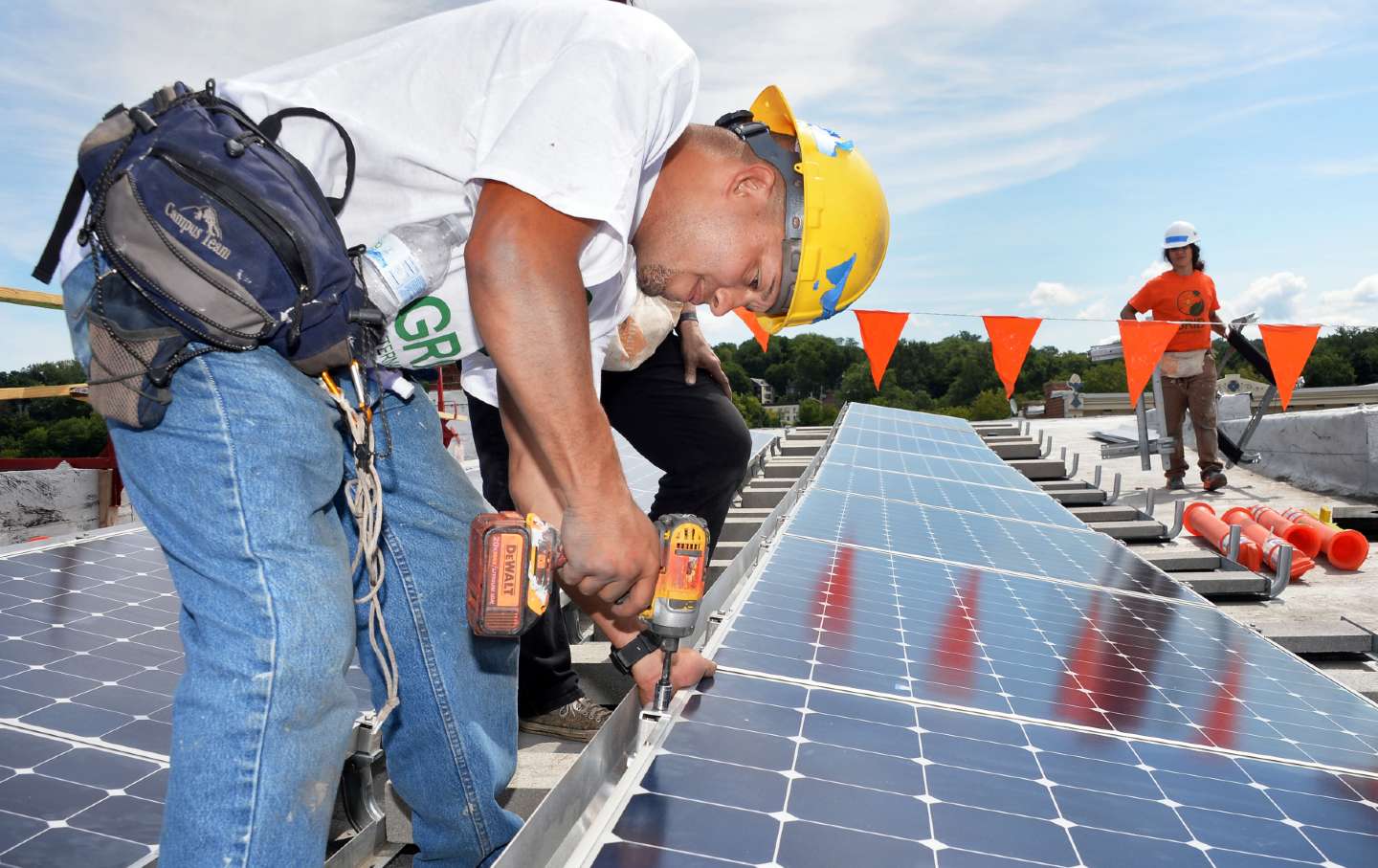
This Solar Panel Kills Fascists This Solar Panel Kills Fascists
New York’s Build Public Renewables Act will reduce carbon in the atmosphere, combat inequality, and help workers. It might also defeat Trumpism.
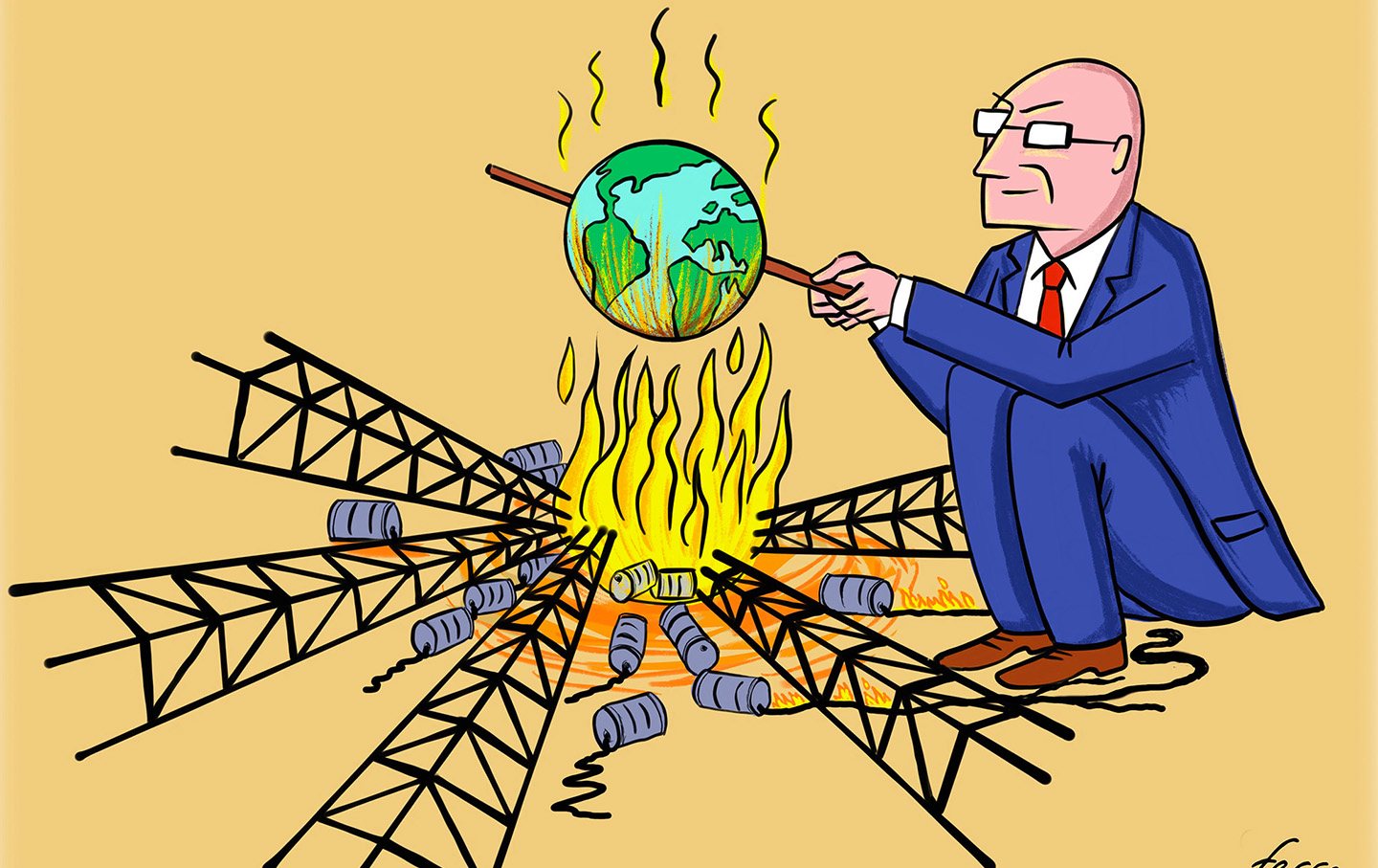
Global Burning Global Burning
The oil industry denies climate change, opposes regulations, and significantly contributes to the environmental crisis.
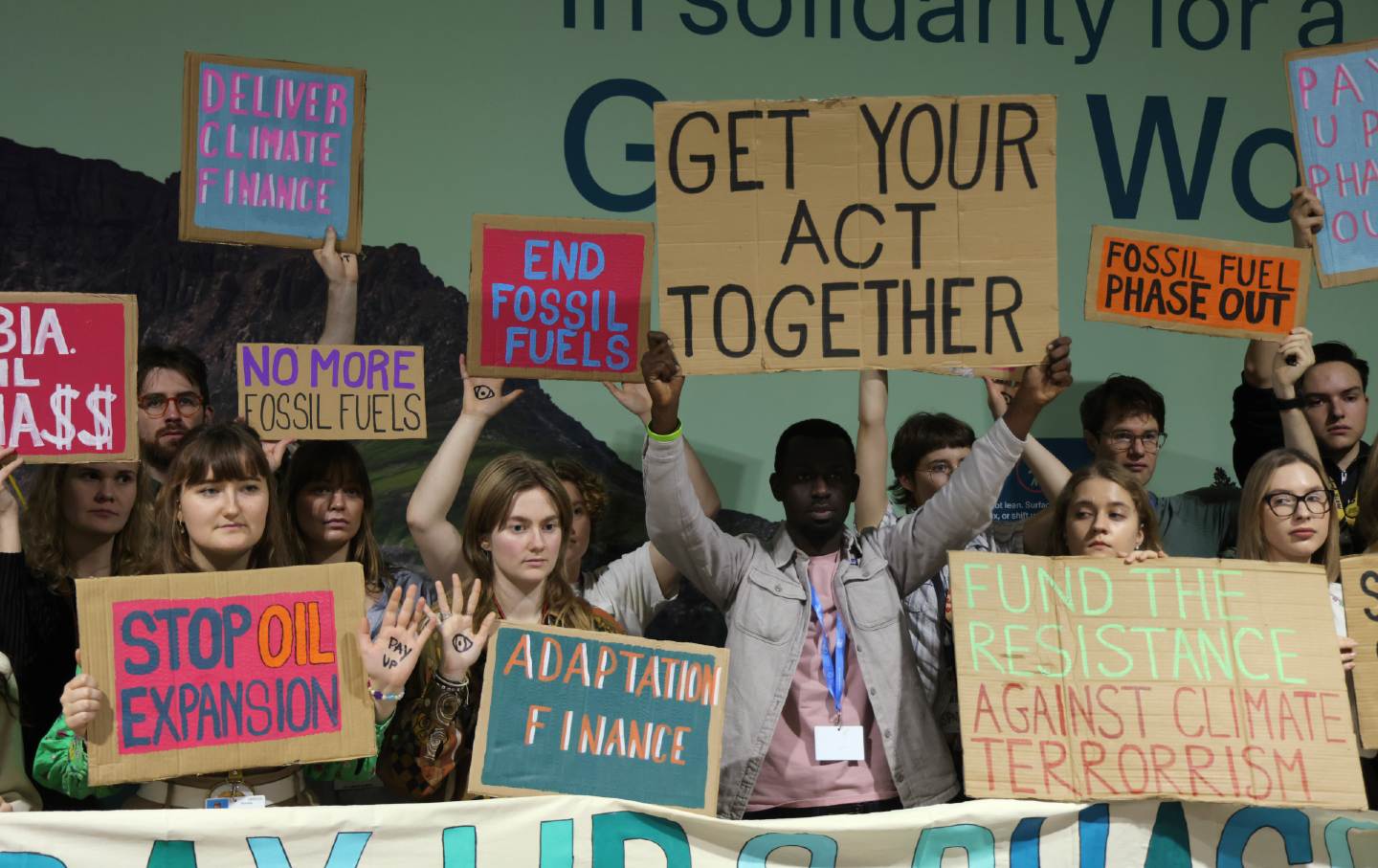
The “Worst COP” Concludes With a “Heartbreaking” Climate-Finance Deal The “Worst COP” Concludes With a “Heartbreaking” Climate-Finance Deal
Activists say the climate agreement effectively signed away the 1.5-degree Celsius target—”our only real chance to safeguard humanity’s future.”

Climate Change Is the Real National Security Threat Climate Change Is the Real National Security Threat
In the wake of Hurricanes Helene and Milton, it’s clear we’re defending against the wrong perils.
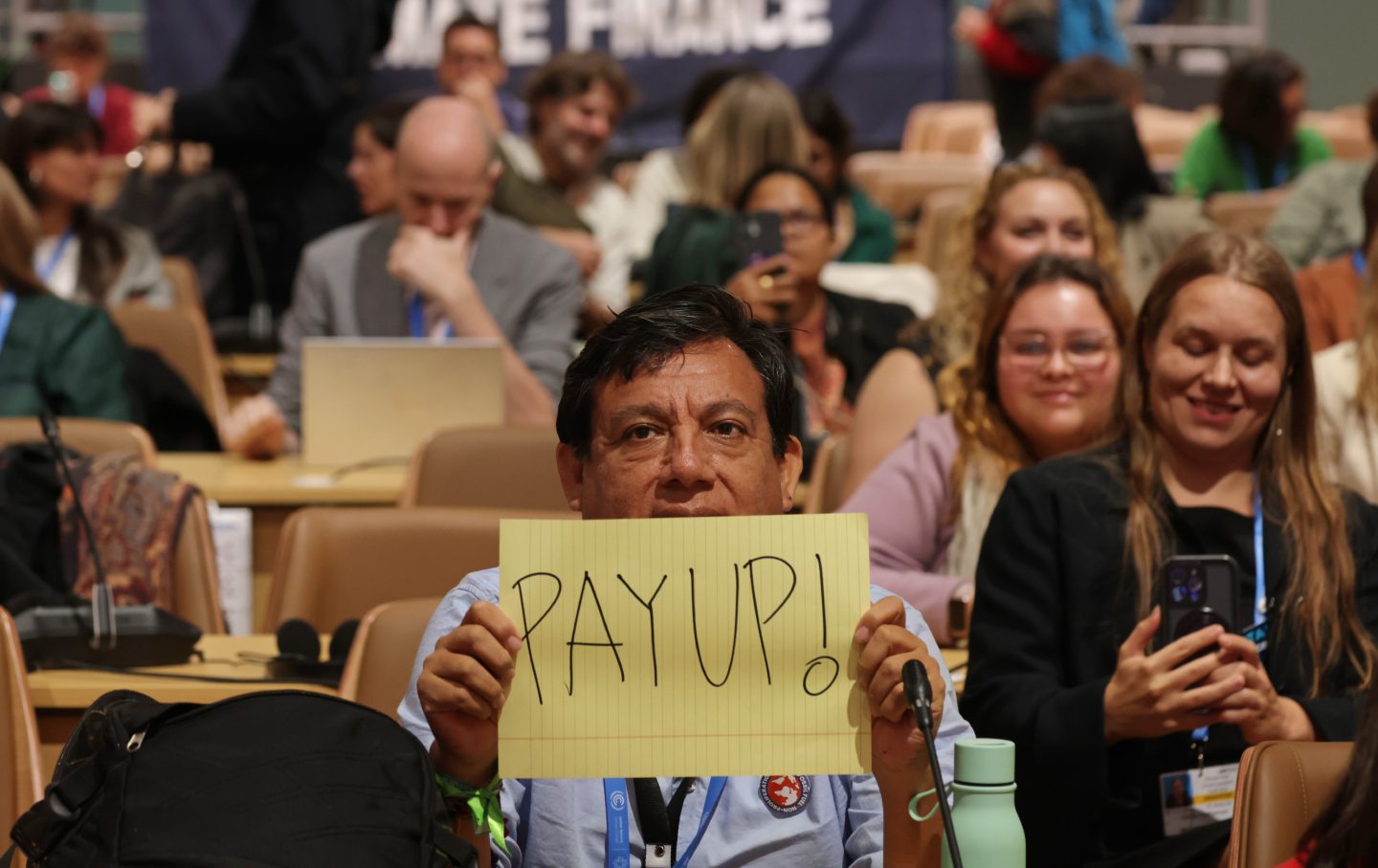
Rich Countries Must Pay Up or Humanity Will Pay the Price Rich Countries Must Pay Up or Humanity Will Pay the Price
The climate activist Lidy Nacpil says the climate bill owed to developing nations is in the “trillions, not billions.”

Acting on Climate Change? Acting on Climate Change?
The opportunity is melting away.


